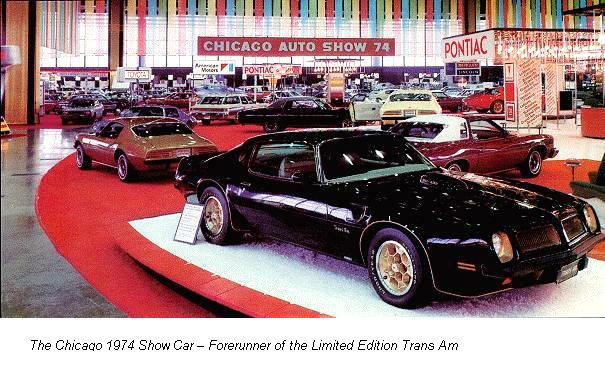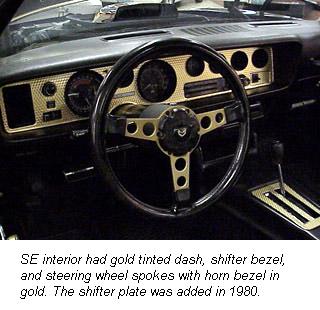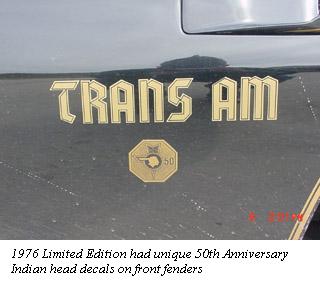Bandit Trans Am History, Part I
Back to Hoghead's Bandit Page
Pat Smith has written a fine article about the early history and development of the Special Edition, and he has given us permission to include it here.
See also Part II, which covers 1978-81.
Trans Am Special Editions
By: Patrick Smith
They were cars that defined being young and free in the 1970s. More than any
other make, Pontiac carried the muscle car image with style and the essential
hardware that gained instant street credibility. The Firebird Trans Am (T/A)
increasingly took on the performance role through the decade when others fell
and took flight. Z/28 just plain left the stadium from 1975 to 1977. There’s no
such thing as half time in the auto sales game. Pontiac stood and delivered the
goods. They did it using every trick in the book. One of the best had to be the
Special Edition model T/A.
Young teens and pre teens from the 1970’s are now buying what got them
excited about cars as kids. For many men and women, that buzz was the Trans Am
Special Edition. Also known in the 70’s as Blackbirds, Bandit T/A’s, Georgia
State specials, these were T/As finished in black paint with gold pin striping
and the impressive hood bird decal in gold and black. Let’s start at the
beginning and document how these cars came to be.
We have to go back to 1970, at GM styling studios with chief designer for the
Firebird, Bill Porter and Ted Schroeder, designers of the Trans Am 1970 package.
They’d created two cars for the show circuit: one in white with the blue bird on
the hood, plus a blue T/A with a white bird on the hood. Ted Schroeder recalled
drawing up the large bird and sending it to GM’s Design Staff. There, Norm
Inouye prepared the image for Minnesota Mines and Materials to make test
samples. The showcars had them on when head of Design Staff, Bill Mitchell
happened to be in the studios. A conservative man when it came to styling, he
was not amused. In no uncertain terms, he let know Bill Porter know how much he
hated the hood birds.
It would’ve been all over had John Schinella not become the new chief
designer for Firebird in 1971. The addition of Buccaneer Red and Brewster Green
to the palette for 1973
T/A’s meant a new lease on life for the hood bird. John Schinella
used one of the hood bird graphics on a red T/A with an orange background colour
and test-drove the combination around Michigan. Word on the street was
overwhelmingly positive from Nine-Mile road to Royal Oak and Woodward Avenue.
Schinella did a T/A in Bill Mitchell’s preferred colours of black paint with a
gold hood bird and gold pinstripes. It was basically the scheme of the John
Player Special sponsored grand prix racers. Bill Mitchell loved this particular
combination and when he heard that the young turks on the street liked the red
and black version, he let the hood decal go out as an option for 1973.
That fateful day planted the idea of a Special Edition T/A. A few other
things happened first though. For the 1974 car show season, a black and gold T/A
was prepared for display in America. It sported a SD 455 under the shaker hood,
it was Pontiac’s latest performance weapon released in 1973.
 The show car had black metalflake paint with a gold and black hood bird and pin
striping on various body components including the fender spats, racing mirrors,
A-pillar, the roof and trunk lid centreline and the hood scoop surround. It was
a stunning car especially with the honeycomb mag wheels. The ’74 showcar also
had "Trans Am" in gold gothic lettering on the front fenders.
The show car had black metalflake paint with a gold and black hood bird and pin
striping on various body components including the fender spats, racing mirrors,
A-pillar, the roof and trunk lid centreline and the hood scoop surround. It was
a stunning car especially with the honeycomb mag wheels. The ’74 showcar also
had "Trans Am" in gold gothic lettering on the front fenders.
The next step was the 1976 Limited Edition (L/E) Trans Am made to commemorate
Pontiac’s 50th year in business. This was the unofficial start of the Special
Edition series. These were produced in one colour only. Starlight Black was new
for Firebird in 1976 although available on GTOs since 1970. It came with
extensive pin striping, black and gold hood bird, Trans Am in gold gothic
lettering on the front fenders and rear spoiler, plus special gold accented
honeycomb wheels, grille inserts and headlamp bezels.
 You also got a gold tinted engine
turned dash plate, matching gold accented Formula steering wheel, and a gold
Firebird logo to match the shift knob. There were also gold Firebirds on the
steering wheel horn button and the window crank inserts that came with power
windows.
You also got a gold tinted engine
turned dash plate, matching gold accented Formula steering wheel, and a gold
Firebird logo to match the shift knob. There were also gold Firebirds on the
steering wheel horn button and the window crank inserts that came with power
windows.
Unlike the showcar, these L/Es also came with a brand new feature option
called the hatch roof. An invention by Hurst-Campbell Industries, the dark
tinted glass panels were installed away from the Norwood plant. The hatches were
installed using power tools and templates. The installation quality varied from
good to fair. Original ’77 Y-82 owner, Mike Barefoot, noted his car had
installation lines in bright yellow indicating where to cut the roof. Mike
observed a rough quality almost as if tin snips were used. These marks were
concealed once the hatch panel liners were installed. There were design problems
with the early Hurst hatches and this ended up altering the Limited Edition
package.
SE owners learn quickly to distinguish between 1st and 2nd
generation Hurst hatches. Early Hurst hatches used different frames to hold the
glass in place. The weather stripping was different as well. The second version
of Hurst hatches use larger frames but the glass itself was the same.
 According
to the first Sales Information Bulletin released February 25, 1976 to Pontiac
dealers, the production start up was slated for April 1 and only 2,400 Limited
Editions T/As were to be made. The sales code was Y-82. This meant a Hurst hatch
roof option exclusive to the Limited Edition T/As until their run was complete.
Pontiac planned to make the hatch panels optional on all Firebirds after the ’76
LE cars were completed
According
to the first Sales Information Bulletin released February 25, 1976 to Pontiac
dealers, the production start up was slated for April 1 and only 2,400 Limited
Editions T/As were to be made. The sales code was Y-82. This meant a Hurst hatch
roof option exclusive to the Limited Edition T/As until their run was complete.
Pontiac planned to make the hatch panels optional on all Firebirds after the ’76
LE cars were completed
.
This didn’t happen until 1977. The original bulletin also mentioned gold
lettered tires in GR70x15 size being part of the package.
Despite the extra $1,100 outlay, buyers were lining up to get one of these
cars. Pontiac planned to make 2,400, but only had 643 T/As with Hurst hatches
available. To meet the demand Pontiac let quite a few of the Limited Editions go
through without hatches.
In The
factory parlance for this was Y-81. Since they were all supposed to have
hatches, all the build sheets and cowl tags for Limited Editions were stamped
Y-82. To date, the Bandit T/A club in Wisconsin, USA, has not located a single
1976 L/E solid roof with Y-81 as in either the build sheet or cowl tag.
Pontiac decided to continue the program as early as March 25, 1976. An
updated sales bulletin to dealers delivered some good news with the bad. The
gold lettered tires were not available after all. Delays from parts suppliers
had pushed the start of L/E production past April 1st. The good news
for dealers was there would be a chance to cash in for 1977 with a repeat of the
1976 scheme. The 1977 versions were called Special Editions to separate them
from the 50th Anniversary models. The Y-82 was born flying with both
wings.
1977 was the year the Y-82 landed a spot in the movies and became a screen
legend beside Burt Reynolds, Sally Fields and Jackie Gleason. Titled Smokey
and the Bandit, the movie was a big cops-and-robbers chase spectacular with
Burt helping a trucker deliver some suds by acting as heat magnet for Sheriff
Buford T Justice, played by Gleason. The film was made in 1976 using several
Trans Ams equipped with what would be the SE package. With lots of comedy and
action, the movie was a box office hit. This kind of product placement
advertising was invaluable. Pontiac was instantly rewarded with high showroom
traffic and virtually every "Bandit" T/A selling for sticker price.
Sales of 1977 SE’s were high with 13,706 T-top models sold. The solid roof,
known as Y-81 was less plentiful, only 1,861 made. The engine choices in ’77
were either a Pontiac 400 with TH350 trans, a high perf Pontiac 400 with manual
four speed Super T-10, or the high perf 400 mill was also available with the
TH350. The third choice was an Oldsmobile 403 with TH350 tranny. The rare birds
were Y-81s with the 4-speed equipped mill. Only 384 were made. Any four-gear
Bandit is rare with just 3,083 made. The L78 was the most common T/A engine,
delivering 180 hp, while the performance W72 400 kicked out 200 hp. The Olds 403
had 185 hp. Used as the default mill in California, the 403 had a low profile in
1977.
The engine was a huge part of the success formula. The W72 was the hot rod
mill and you could get it with an automatic or manual transmission. Just how hot
were these engines? Joe Oldham writing for Street Racer magazine, tested
a ’77 W-72 automatic and ran a high ET of 15.50 @92 mph. With some adjusting of
launch technique and tire pressures, he got it to a low of 14.90. The secret to
these great ET rested with the W72 Performance Package.
Coded as "W72 Perf Package" on the build sheets, this engine was hot. A
camshaft analysis of all 3 W72 cams was done using Perf Trends Analyser computer
that simulates dragstrip performance. The cams were compared to the 066, 067 and
068 Pontiac grinds from the early 70’s and late sixties. The results were
astonishing. The W72 camshafts performed better than the 066 and 067 grinds. The
W72 p/n 549112 in particular gave the best overall power of the bunch. When
stacked against the 068 grind, known as the HO 400 camshaft, this particular W72
cam did very well until the upper rpm range where the 068 kept its edge. On the
strip, it would mean a 1 to 2 mph difference at the traps. This was excellent
for a 1970’s "emissions oriented camshaft" according to John Witzke, POCI/NFTAC
tech advisor for the W-72 performance package. John Witzke is the guru for W72
Pontiac 400 mills and has recently written in-depth, new research on this engine
in Smoke Signals magazine. As great as it was, Pontiac had more to give
us in 1978. Tune in next time for the Y-88, the WS-6 and 1980 Turbo Bandit era.
Back to Hoghead's Bandit Page
Forward to Bandit Trans Am History, Part II
 The show car had black metalflake paint with a gold and black hood bird and pin
striping on various body components including the fender spats, racing mirrors,
A-pillar, the roof and trunk lid centreline and the hood scoop surround. It was
a stunning car especially with the honeycomb mag wheels. The ’74 showcar also
had "Trans Am" in gold gothic lettering on the front fenders.
The show car had black metalflake paint with a gold and black hood bird and pin
striping on various body components including the fender spats, racing mirrors,
A-pillar, the roof and trunk lid centreline and the hood scoop surround. It was
a stunning car especially with the honeycomb mag wheels. The ’74 showcar also
had "Trans Am" in gold gothic lettering on the front fenders. You also got a gold tinted engine
turned dash plate, matching gold accented Formula steering wheel, and a gold
Firebird logo to match the shift knob. There were also gold Firebirds on the
steering wheel horn button and the window crank inserts that came with power
windows.
You also got a gold tinted engine
turned dash plate, matching gold accented Formula steering wheel, and a gold
Firebird logo to match the shift knob. There were also gold Firebirds on the
steering wheel horn button and the window crank inserts that came with power
windows.
 According
to the first Sales Information Bulletin released February 25, 1976 to Pontiac
dealers, the production start up was slated for April 1 and only 2,400 Limited
Editions T/As were to be made. The sales code was Y-82. This meant a Hurst hatch
roof option exclusive to the Limited Edition T/As until their run was complete.
Pontiac planned to make the hatch panels optional on all Firebirds after the ’76
LE cars were completed
According
to the first Sales Information Bulletin released February 25, 1976 to Pontiac
dealers, the production start up was slated for April 1 and only 2,400 Limited
Editions T/As were to be made. The sales code was Y-82. This meant a Hurst hatch
roof option exclusive to the Limited Edition T/As until their run was complete.
Pontiac planned to make the hatch panels optional on all Firebirds after the ’76
LE cars were completed